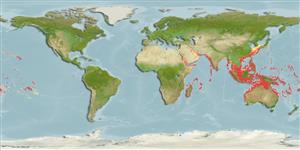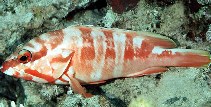Epinephelus fasciatus (Forsskål, 1775)
Blacktip grouper
Add your observation in Fish Watcher
| Native range | All suitable habitat | Point map | Year 2050 |

|
| This map was computer-generated and has not yet been reviewed. |
| Epinephelus fasciatus AquaMaps Data sources: GBIF OBIS |
Upload your photos and videos
Pictures | Videos | Stamps, coins, misc. | Google imageEpinephelus fasciatus
Picture by Randall, J.E.
Pictures | Videos | Stamps, coins, misc. | Google imageEpinephelus fasciatus
Picture by Randall, J.E.
Reunion Island [La] (La Réunion) country information
Common names:
Mérou oriflamime, Rouge de côte, Rougette
Occurrence: native
Salinity: marine
Abundance: abundant (always seen in some numbers) | Ref: Taquet, M. and A. Diringer, 1992
Importance: | Ref:
Aquaculture: | Ref:
Regulations: | Ref:
Uses: no uses
Comments: Common depth: 10-150 m. Max length: 40 cm (Ref. 89967). Common length: 15-20 m (Ref. 89967). Museum: MNHN 4717, 1975-719 (Ref. 4787). MHNRUN 211, 247, 371; MNHN 1994-0521, 1998-0501 (Ref. 33390). Also Ref. 5222.
National Checklist:
Country Information: https://www.cia.gov/library/publications/resources/the-world-factbook/geos/re.html
National Fisheries Authority:
Occurrences: Occurrences Point map
Main Ref: Letourneur, Y., P. Chabanet, P. Durville, M. Taquet, E. Teissier, M. Parmentier, J.-C. Quéro and K. Pothin, 2004
National Database:
Occurrence: native
Salinity: marine
Abundance: abundant (always seen in some numbers) | Ref: Taquet, M. and A. Diringer, 1992
Importance: | Ref:
Aquaculture: | Ref:
Regulations: | Ref:
Uses: no uses
Comments: Common depth: 10-150 m. Max length: 40 cm (Ref. 89967). Common length: 15-20 m (Ref. 89967). Museum: MNHN 4717, 1975-719 (Ref. 4787). MHNRUN 211, 247, 371; MNHN 1994-0521, 1998-0501 (Ref. 33390). Also Ref. 5222.
National Checklist:
Country Information: https://www.cia.gov/library/publications/resources/the-world-factbook/geos/re.html
National Fisheries Authority:
Occurrences: Occurrences Point map
Main Ref: Letourneur, Y., P. Chabanet, P. Durville, M. Taquet, E. Teissier, M. Parmentier, J.-C. Quéro and K. Pothin, 2004
National Database:
Common names from other countries
Classification / Names Tên thường gặp | Các synonym ( Các tên trùng) | Catalog of Fishes(Giống, Các loài) | ITIS | CoL | WoRMS | Cloffa
> Perciformes/Serranoidei (Groupers) > Epinephelidae (Groupers)
Etymology: Epinephelus: Greek, epinephelos = cloudy (Ref. 45335).
More on author: Forsskål.
Etymology: Epinephelus: Greek, epinephelos = cloudy (Ref. 45335).
More on author: Forsskål.
Environment: milieu / climate zone / depth range / distribution range Sinh thái học
Biển; Thuộc về nước lợ Cùng sống ở rạn san hô; Mức độ sâu 4 - 160 m (Ref. 5222), usually 20 - 45 m (Ref. 5222). Tropical; 36°N - 35°S, 22°E - 124°W
Sự phân bố Các nước | Các khu vực của FAO | Các hệ sinh thái | Những lần xuất hiện | Point map | Những chỉ dẫn | Faunafri
Indo-Pacific: Red Sea to South Africa and eastward to the Pitcairn Group, north to Japan and Korea, south to the Arafura Sea (Ref. 9819), southern Queensland (Australia) and Lord Howe Island.
Length at first maturity / Bộ gần gũi / Khối lượng (Trọng lượng) / Age
Maturity: Lm ?, range 16 - ? cm
Max length : 52.0 cm TL con đực/không giới tính; (Ref. 1238); common length : 22.0 cm TL con đực/không giới tính; (Ref. 5450); Khối lượng cực đại được công bố: 2.0 kg (Ref. 30874)
Max length : 52.0 cm TL con đực/không giới tính; (Ref. 1238); common length : 22.0 cm TL con đực/không giới tính; (Ref. 5450); Khối lượng cực đại được công bố: 2.0 kg (Ref. 30874)
Short description Khóa để định loại | Hình thái học | Sinh trắc học
Các tia vây lưng cứng (tổng cộng) : 11; Các vây lưng mềm (tổng cộng) : 15 - 17; Tia cứng vây hậu môn: 3; Tia mềm vây hậu môn: 8. This species is distinguished by the following characters: body depth 2.8-3.3 in SL (for specimens 10-26 cm SL); head length 2.3-2.6 in SL; flat interorbital area, convex dorsal head profile; snout length 4.3-5.1 in HL; preopercle rounded, rear edge serrate, with lower most serrae slightly enlarged; upper edge of operculum straight; midlateral part of lower jaw with 2-4 rows of teeth; gill rakers of first gill arch 6-8 + 15-17; pyloric caeca 10-16; caudal fin slightly to moderately rounded (Central-Pacific often with truncate caudal fins); ctenoid scales on body except cycloid anterodorsally above lateral line and on thorax and ventrally on abdomen, with numerous auxiliary scales; nape and dorsoposterior part of head densely covered with minute auxiliary scales; lateral-line scales 49-75. Colour variable, ranging from pale greenish grey to pale reddish yellow to scarlet; body often with 5 or 6 faint dark bars, the last on peduncle; body scales (except ventrally) with pale centre and dark rear margin, producing a faint checked pattern; the outer triangular part of interspinous membranes of dorsal fin black (dark red in fish from Western Australia and in some specimens from deep water), with pale yellow or white spot behind tip of each spine (Ref. 39231, 89707, 90102).
Common in outer reef slopes at depths below 15 m, also occurs in protected bays and lagoons as shallow as 4 m. May also be found down to a depth of 160 m. At Madagascar it feeds night and day on brachyuran crabs, fishes, shrimps, and galatheid crabs (Ref. 6774). In Kenyan waters it feeds on crabs, stomatopods, fishes, ophiuroids, and octopus (Ref. 6448). In the Red Sea, mostly fishes and some crustaceans (mainly crabs) are consumed (Ref. 6699). Readily caught with hook-and-line, spear, traps, and gill nets (Ref. 39231)..
Life cycle and mating behavior Chín muồi sinh dục | Sự tái sinh sản | Đẻ trứng | Các trứng | Sự sinh sản | Ấu trùng
This species exhibits a combination of simultaneous and sequential hermaphroditism. Smaller individuals within a social group are simultaneous hermaphrodites, while the largest often lose female function and reproduce exclusively as a male (Ref. 103751).
Main reference
Upload your references | Các tài liệu tham khảo | Người điều phối | Người cộng tác
Heemstra, P.C. and J.E. Randall, 1993. FAO Species Catalogue. Vol. 16. Groupers of the world (family Serranidae, subfamily Epinephelinae). An annotated and illustrated catalogue of the grouper, rockcod, hind, coral grouper and lyretail species known to date. Rome: FAO. FAO Fish. Synop. 125(16):382 p. (Ref. 5222)
IUCN Red List Status (Ref. 130435: Version 2024-2)
Least Concern (LC) ; Date assessed: 21 November 2016
Human uses
Các nghề cá: Tính thương mại; cá để chơi: đúng; Bể nuôi cá: Tính thương mại
FAO(Các nghề cá: Sản xuất; publication : search) | FishSource | Biển chung quanh ta
Thêm thông tin
Trophic ecology
Các loại thức ăn
Thành phần thức ăn
Thành phần thức ăn
Food rations
Các động vật ăn mồi
Các loại thức ăn
Thành phần thức ăn
Thành phần thức ăn
Food rations
Các động vật ăn mồi
Population dynamics
Growth parameters
Max. ages / sizes
Length-weight rel.
Length-length rel.
Length-frequencies
Mass conversion
Bổ xung
Sự phong phú
Growth parameters
Max. ages / sizes
Length-weight rel.
Length-length rel.
Length-frequencies
Mass conversion
Bổ xung
Sự phong phú
Life cycle
Sự tái sinh sản
Chín muồi sinh dục
Sự sinh sản
Đẻ trứng
Spawning aggregations
Các trứng
Egg development
Ấu trùng
Sự biến động ấu trùng
Sự tái sinh sản
Chín muồi sinh dục
Sự sinh sản
Đẻ trứng
Spawning aggregations
Các trứng
Egg development
Ấu trùng
Sự biến động ấu trùng
Distribution
Các nước
Các khu vực của FAO
Các hệ sinh thái
Những lần xuất hiện
Những chỉ dẫn
BRUVS - Videos
Các nước
Các khu vực của FAO
Các hệ sinh thái
Những lần xuất hiện
Những chỉ dẫn
BRUVS - Videos
Physiology
Body composition
Nutrients
Thành phần ô-xy
Dạng bơi
Tốc độ bơi
Visual pigments
Fish sound
Diseases & Parasites
Toxicity (LC50s)
Body composition
Nutrients
Thành phần ô-xy
Dạng bơi
Tốc độ bơi
Visual pigments
Fish sound
Diseases & Parasites
Toxicity (LC50s)
Human related
Aquaculture systems
Các tổng quan nuôi trồng thủy sản
Các giống
Ciguatera cases
Stamps, coins, misc.
Aquaculture systems
Các tổng quan nuôi trồng thủy sản
Các giống
Ciguatera cases
Stamps, coins, misc.
Các công cụ
Bio-Quiz | E-book | Hướng dẫn hiện trường | Khóa để định loại | Tần suất chiều dài Wizard | Công cụ của vòng đời | Bản đồ điểm | Classification Tree
| Catch-MSY |
Special reports
Download XML
Các nguồn internet
Alien/Invasive Species database | Aquatic Commons | BHL | Cloffa | BOLDSystems | Websites from users | Check FishWatcher | CISTI | Catalog of Fishes(Giống, Các loài) | DiscoverLife | DORIS | ECOTOX | Faunafri | Fishtrace | GenBank(genome, nucleotide) | GloBI | GOBASE | | Google Books | Google Scholar | Google | IGFA World Record | MitoFish | Các cơ sở dữ liệu quốc gia | Otolith Atlas of Taiwan Fishes | Bể cá công cộng | PubMed | Reef Life Survey | Scirus | SeaLifeBase | Cây Đời sống | Wikipedia(Go, tìm) | World Records Freshwater Fishing | Tạp chí Zoological Record
Estimates based on models
Preferred temperature (Ref. 115969): 24.5 - 29, mean 28 (based on 1100 cells).
Phylogenetic diversity index (Ref. 82804): PD50 = 0.5000 [Uniqueness, from 0.5 = low to 2.0 = high].
Bayesian length-weight: a=0.01148 (0.01022 - 0.01289), b=3.03 (3.01 - 3.05), in cm Total Length, based on LWR estimates for this species (Ref. 93245).
Mức dinh dưỡng (Ref. 69278): 3.7 ±0.4 se; based on diet studies.
Thích nghi nhanh (Ref. 120179): thấp, thời gian nhân đôi của chủng quần tối thiểu là 4.5 - 14 năm (K=0.16).
Fishing Vulnerability (Ref. 59153): Moderate to high vulnerability (54 of 100).
Climate Vulnerability (Ref. 125649): Moderate to high vulnerability (54 of 100).




